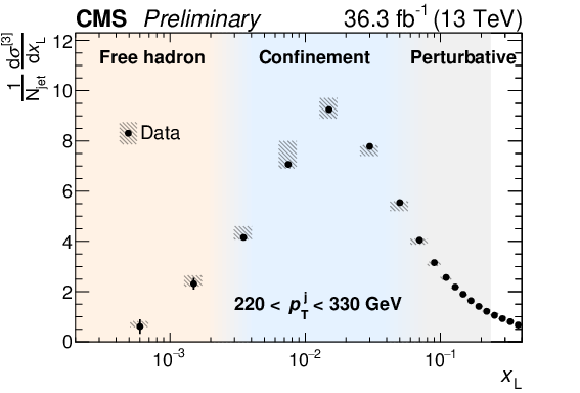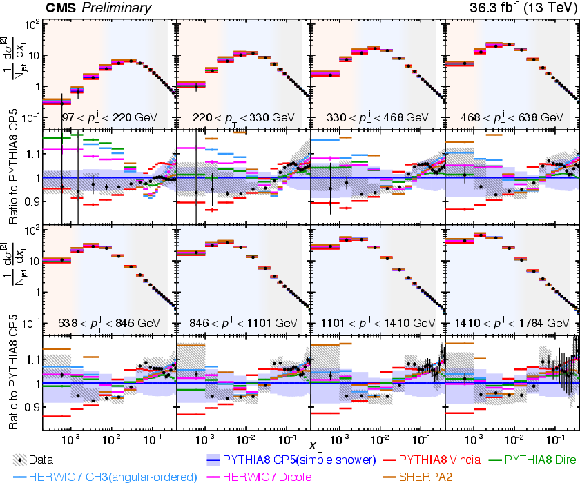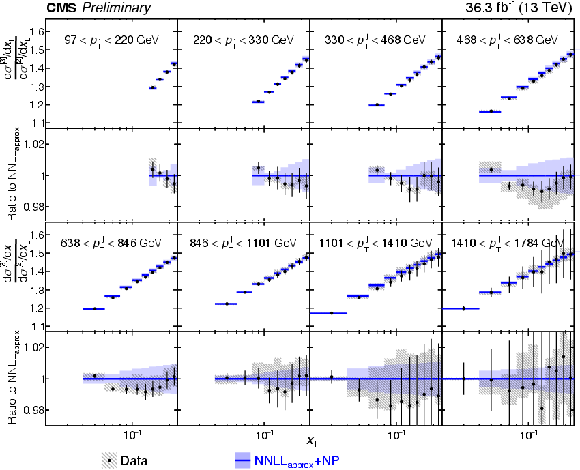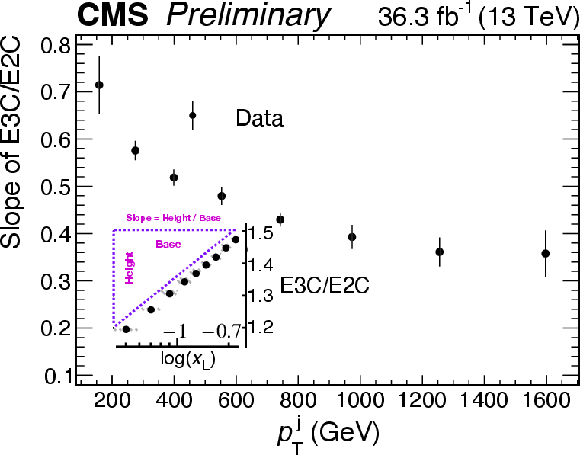

Compact Muon Solenoid
LHC, CERN
| CMS-PAS-SMP-22-015 | ||
| Measurement of energy correlators inside jets and determination of the strong coupling constant | ||
| CMS Collaboration | ||
| 2 August 2023 | ||
| Abstract: We measure the two-point and three-point energy correlator jet substructure observables (E2C and E3C), using LHC 13 TeV data collected by the CMS experiment. These measurements reveal in a straightforward way the two most important features of strong interactions, confinement and asymptotic freedom. The E2C and E3C distributions show a sharp transition from the falling scaling behavior characterizing the quantum interactions of quarks and gluons to an integer power law reflective of classical noninteracting hadrons. The ratio of E3C/E2C is directly proportional to the strong coupling constant $ \alpha_S $. The slopes of the ratio of the distribution of E3C and E2C are measured in multiple jet transverse momentum regions, consistent with the expected decrease of $ \alpha_S $ with increasing energy due to asymptotic freedom. Measurements of scaling behavior are compared to theoretical predictions with all-orders resummation at next-to-next-to-leading logarithmic accuracy matched to a fixed-order next-to-leading order calculation, yielding an $ \alpha_S (m_{\mathrm{Z}}) $ value of 0.1229$ ^{+0.0040}_{-0.0050} $. This is the most precise extraction of $ \alpha_S (m_{\mathrm{Z}}) $ using jet substructure observables to date. | ||
|
Links:
CDS record (PDF) ;
Physics Briefing ;
CADI line (restricted) ;
These preliminary results are superseded in this paper, Submitted to PRL. The superseded preliminary plots can be found here. |
||
| Figures | |

png pdf |
Figure 1:
Unfolded data distribution of E3C using jets in the $ p_{\mathrm{T}} $ range between 220 and 330 GeV. The error bars for unfolded data distribution account for the correlated nature of the input data. Experimental uncertainties are presented by error bands around data. Three distinct regions are observed, marking a clear transition from interacting quarks and gluons to noninteracting hadrons. The two boundaries are approximately 0.8 GeV/$p_{\mathrm{T}}^{\mathrm{j}} $ and 20 GeV/$p_{\mathrm{T}}^{\mathrm{j}} $ and are explained in detail in the text. |

png pdf |
Figure 2:
Unfolded E2C (upper) and E3C (bottom) distributions in data compared to MC predictions. The data are unfolded using migration matrices from PYTHIA8 simulation (black). Error bars in data distributions are statistical uncertainties, while experimental systematic uncertainties are shown in grey bands. The predictions from different simulations are shown for comparison. Theoretical uncertainty of PYTHIA8 CP5(simple shower) is shown in the blue bands. The two boundaries are approximately 0.8 GeV/$p_{\mathrm{T}}^{\mathrm{j}} $ and 20 GeV/$p_{\mathrm{T}}^{\mathrm{j}} $ and are explained in detail in the texts. |

png pdf |
Figure 2-a:
Unfolded E2C (upper) and E3C (bottom) distributions in data compared to MC predictions. The data are unfolded using migration matrices from PYTHIA8 simulation (black). Error bars in data distributions are statistical uncertainties, while experimental systematic uncertainties are shown in grey bands. The predictions from different simulations are shown for comparison. Theoretical uncertainty of PYTHIA8 CP5(simple shower) is shown in the blue bands. The two boundaries are approximately 0.8 GeV/$p_{\mathrm{T}}^{\mathrm{j}} $ and 20 GeV/$p_{\mathrm{T}}^{\mathrm{j}} $ and are explained in detail in the texts. |

png pdf |
Figure 2-b:
Unfolded E2C (upper) and E3C (bottom) distributions in data compared to MC predictions. The data are unfolded using migration matrices from PYTHIA8 simulation (black). Error bars in data distributions are statistical uncertainties, while experimental systematic uncertainties are shown in grey bands. The predictions from different simulations are shown for comparison. Theoretical uncertainty of PYTHIA8 CP5(simple shower) is shown in the blue bands. The two boundaries are approximately 0.8 GeV/$p_{\mathrm{T}}^{\mathrm{j}} $ and 20 GeV/$p_{\mathrm{T}}^{\mathrm{j}} $ and are explained in detail in the texts. |

png pdf |
Figure 3:
Unfolded E3C/E2C distributions in data, compared to theoretical predictions in the perturbative region. The data are unfolded using migration matrices in PYTHIA8 simulation (black). Error bars in data distributions are statistical uncertainties, systematic experimental systematic uncertainties are shown in grey bands. Theoretical predictions are calculated with resummation at NNLL accuracy matched to a fixed-order calculation at NLO ($ \textrm{NNLL}_{\text{approx}} $) [45] and corrected to the hadron level using NP corrections. The average NP factors are obtained with PYTHIA8 and with HERWIG 7 and are applied bin by bin. The comparison between the data distributions and theoretical predictions are used to extract $ \alpha_S (m_{\mathrm{Z}}) $. |

png pdf |
Figure 4:
The fitted slopes of the E3C/E2C data distributions as a function of jet $ p_{\mathrm{T}} $ are used to illustrate the dependency of $ \alpha_S $ on jet $ p_{\mathrm{T}} $. A clear decreasing trend with jet $ p_{\mathrm{T}} $ is seen, demonstrating that the strong coupling gets weaker at higher energy scales. |
| Summary |
| The measurement of the two-point and three-point energy correlators is presented in this work. A multidimensional unfolding of the jet $ p_{\mathrm{T}} $, and the angular distance and energy weight of the particle pair is performed to take into account the correlation between these variables. Comparisons to various parton shower simulations are also presented. These results provide a new means of studying QCD in collider experiments, and can help validate future higher-order implementations in parton showers. The distinctive phases of jet formation that are embedded in the energy correlators provide approaches to understand the time scale of hadron formation, which remains an open question in QCD [80]. The $ \alpha_S (m_{\mathrm{Z}}) $ value extracted from the ratio of the three-point and two-point correlators is 0.1229$ ^{+0.0040}_{-0.0050} $. This represents the most precise determination of $ \alpha_S $ using jet substructure techniques to date. The precision greatly advances the previous expectation of 10% due to the development of novel jet substructure observables and the availability of higher-order theoretical calculations. |
| References | ||||
| 1 | D. J. Gross and F. Wilczek | Asymptotically free gauge theories - 1 | PRD 8 (1973) 3633 | |
| 2 | D. J. Gross and F. Wilczek | Ultraviolet behavior of nonabelian gauge theories | PRL 30 (1973) 1343 | |
| 3 | H. D. Politzer | Reliable perturbative results for strong interactions? | PRL 30 (1973) 1346 | |
| 4 | D. J. Gross and F. Wilczek | Asymptotically free gauge theories - 2 | PRD 9 (1974) 980 | |
| 5 | J. Currie, A. Gehrmann-De Ridder, E. W. N. Glover, and J. Pires | NNLO qcd corrections to jet production at hadron colliders from gluon scattering | JHEP 01 (2014) 110 | 1310.3993 |
| 6 | J. Currie, E. W. N. Glover, and J. Pires | Next-to-next-to leading order QCD predictions for single jet inclusive production at the LHC | PRL 118 (2017) 072002 | 1611.01460 |
| 7 | C. Anastasiou et al. | Higgs boson gluon-fusion production in QCD at three loops | PRL 114 (2015) 212001 | 1503.06056 |
| 8 | B. Mistlberger | Higgs boson production at hadron colliders at N$ ^{3} $LO in QCD | JHEP 05 (2018) 028 | 1802.00833 |
| 9 | A. Banfi et al. | Jet-vetoed Higgs cross section in gluon fusion at N$ ^{3} $LO+NNLL with small-$ R $ resummation | JHEP 04 (2016) 049 | 1511.02886 |
| 10 | C. Duhr, F. Dulat, and B. Mistlberger | Charged current Drell-Yan production at N$ ^{3} $LO | JHEP 11 (2020) 143 | 2007.13313 |
| 11 | ATLAS Collaboration | Measurement of the Lund jet plane using charged particles in 13 TeV proton-proton collisions with the ATLAS detector | PRL 124 (2020) 222002 | 2004.03540 |
| 12 | CMS Collaboration | Measurement of the primary Lund jet plane density in proton-proton collisions at $ \sqrt{s} = $ 13 TeV | CMS Physics Analysis Summary, 2023 CMS-PAS-SMP-22-007 |
CMS-PAS-SMP-22-007 |
| 13 | ATLAS Collaboration | Measurement of the jet fragmentation function and transverse profile in proton-proton collisions at a center-of-mass energy of 7 TeV with the ATLAS detector | EPJC 71 (2011) 1795 | 1109.5816 |
| 14 | LHCb Collaboration | Study of J/$\psi$ production in jets | PRL 118 (2017) 192001 | 1701.05116 |
| 15 | CMS Collaboration | Measurement of jet fragmentation in PbPb and pp collisions at $ \sqrt {\smash [b]{s_{_{\mathrm {NN}}}}}= $ 2.76 TeV | Phys. Rev. C 90 (2014) 024908 | CMS-HIN-12-013 1406.0932 |
| 16 | ATLAS Collaboration | Measurement of jet fragmentation in 5.02 TeV proton-lead and proton-proton collisions with the ATLAS detector | Nucl. Phys. A 978 (2018) 65 | 1706.02859 |
| 17 | ALICE Collaboration | Measurements of the groomed and ungroomed jet angularities in pp collisions at $ \sqrt{s} =$ 5.02 TeV | JHEP 05 (2022) 061 | 2107.11303 |
| 18 | CMS Collaboration | Study of quark and gluon jet substructure in dijet and Z+jet events from pp collisions | CMS Physics Analysis Summary, 2021 CMS-PAS-SMP-20-010 |
CMS-PAS-SMP-20-010 |
| 19 | CMS Collaboration | Measurement of the splitting function in pp and Pb-Pb Collisions at $ \sqrt{s_{_{\mathrm{NN}}}} = $ 5.02 TeV | PRL 120 (2018) 142302 | CMS-HIN-16-006 1708.09429 |
| 20 | CMS Collaboration | Shape, transverse size, and charged hadron multiplicity of jets in pp collisions at 7 TeV | JHEP 06 (2012) 160 | CMS-QCD-10-029 1204.3170 |
| 21 | ATLAS Collaboration | Measurement of the soft-drop jet mass in pp collisions at $ \sqrt{s} = $ 13 TeV with the ATLAS detector | PRL 121 (2018) 092001 | 1711.08341 |
| 22 | CMS Collaboration | Measurements of the differential jet cross section as a function of the jet mass in dijet events from proton-proton collisions at $ \sqrt{s}= $ 13 TeV | JHEP 11 (2018) 113 | CMS-SMP-16-010 1807.05974 |
| 23 | ATLAS Collaboration | Measurement of soft-drop jet observables in pp collisions with the ATLAS detector at $ \sqrt {s} =$ 13 TeV | PRD 101 (2020) 052007 | 1912.09837 |
| 24 | ALICE Collaboration | Measurement of the groomed jet radius and momentum splitting fraction in pp and Pb-Pb collisions at $ \sqrt {\smash [b]{s_{_{\mathrm {NN}}}}} = $ 5.02 TeV | PRL 128 (2022) 102001 | 2107.12984 |
| 25 | ALICE Collaboration | Direct observation of the dead-cone effect in quantum chromodynamics | Nature 605 (2022) 440 | 2106.05713 |
| 26 | CMS Collaboration | Measurement of jet substructure observables in $ \mathrm{t\overline{t}} $ events from proton-proton collisions at $ \sqrt{s}= $ 13 TeV | PRD 98 (2018) 092014 | CMS-TOP-17-013 1808.07340 |
| 27 | ALICE Collaboration | Exploration of jet substructure using iterative declustering in pp and Pb-Pb collisions at LHC energies | PLB 802 (2020) 135227 | 1905.02512 |
| 28 | ATLAS Collaboration | Jet mass and substructure of inclusive jets in $ \sqrt{s}= $ 7 TeV pp collisions with the ATLAS experiment | JHEP 05 (2012) 128 | 1203.4606 |
| 29 | ATLAS Collaboration | ATLAS measurements of the properties of jets for boosted particle searches | PRD 86 (2012) 072006 | 1206.5369 |
| 30 | ATLAS Collaboration | Measurement of colour flow with the jet pull angle in $ t\bar{t} $ events using the ATLAS detector at $ \sqrt{s}= $ 8 TeV | PLB 750 (2015) 475 | 1506.05629 |
| 31 | ATLAS Collaboration | Measurement of jet-substructure observables in top quark, W boson and light jet production in proton-proton collisions at $ \sqrt{s}= $ 13 TeV with the ATLAS detector | JHEP 08 (2019) 033 | 1903.02942 |
| 32 | CMS Collaboration | Studies of jet mass in dijet and W/Z + jet events | JHEP 05 (2013) 090 | CMS-SMP-12-019 1303.4811 |
| 33 | LHCb Collaboration | Measurement of charged hadron production in Z-tagged jets in proton-proton collisions at $ \sqrt{s}= $ 8 TeV | PRL 123 (2019) 232001 | 1904.08878 |
| 34 | ATLAS Collaboration | Measurement of jet shapes in top-quark pair events at $ \sqrt{s} =$ 7 TeV using the ATLAS detector | EPJC 73 (2013) 2676 | 1307.5749 |
| 35 | ATLAS Collaboration | Measurement of jet charge in dijet events from $ \sqrt{s} = $ 8 TeV pp collisions with the ATLAS detector | PRD 93 (2016) 052003 | 1509.05190 |
| 36 | CMS Collaboration | Measurements of jet charge with dijet events in pp collisions at $ \sqrt{s}= $ 8 TeV | JHEP 10 (2017) 131 | CMS-SMP-15-003 1706.05868 |
| 37 | CMS Collaboration | Study of quark and gluon jet substructure in Z+jet and dijet events from pp collisions | JHEP 01 (2022) 188 | CMS-SMP-20-010 2109.03340 |
| 38 | H. Chen, I. Moult, X. Zhang, and H. X. Zhu | Rethinking jets with energy correlators: Tracks, resummation, and analytic continuation | PRD 102 (2020) 054012 | 2004.11381 |
| 39 | N. A. Sveshnikov and F. V. Tkachov | Jets and quantum field theory | PLB 382 (1996) 403 | hep-ph/9512370 |
| 40 | A. V. Belitsky et al. | From correlation functions to event shapes | NPB 884 (2014) 305 | 1309.0769 |
| 41 | A. V. Belitsky et al. | Event shapes in $ \mathcal{N} = $ 4 super-Yang-Mills theory | NPB 884 (2014) 206 | 1309.1424 |
| 42 | M. Kologlu, P. Kravchuk, D. Simmons-Duffin, and A. Zhiboedov | The light-ray OPE and conformal colliders | JHEP 01 (2021) 128 | 1905.01311 |
| 43 | L. J. Dixon, I. Moult, and H. X. Zhu | Collinear limit of the energy-energy correlator | PRD 100 (2019) 014009 | 1905.01310 |
| 44 | K. Lee, B. Meçaj, and I. Moult | Conformal colliders meet the LHC | 2205.03414 | |
| 45 | W. Chen et al. | NNLL resummation for projected three-point energy correlator | 2307.07510 | |
| 46 | J. R. Andersen et al., Standard Model Working Group | Les Houches 2017: Physics at TeV colliders | Report, in Proceedings of the Standard Model Working Group of the 2017 Les Houches Workshop (2018) | 1803.07977 |
| 47 | G. P. Salam | The strong coupling: a theoretical perspective | World Scientific, 2019 link |
1712.05165 |
| 48 | S. Moch et al. | High precision fundamental constants at the TeV scale | 1405.4781 | |
| 49 | M. LeBlanc, B. Nachman, and C. Sauer | Going off topics to demix quark and gluon jets in $\alpha _{S} $ extractions | JHEP 02 (2023) 150 | 2206.10642 |
| 50 | ALICE Collaboration | Measurement of the angle between jet axes and energy-energy correlators with ALICE | 11th International Conference on Hard and Electromagnetic Probes of High-Energy Nuclear Collisions, 2023 link |
|
| 51 | STAR Collaboration | Measurement of two-point energy correlators within jets in p+p collisions at $ \sqrt{s} =$ 200 GeV | 11th International Conference on Hard and Electromagnetic Probes of High-Energy Nuclear Collisions, 2023 Conference Talk 1 (2023) 1 |
|
| 52 | V. N. Gribov and L. N. Lipatov | Deep inelastic e p scattering in perturbation theory | Sov. J. Nucl. Phys. 15 (1972) 438 | |
| 53 | Y. L. Dokshitzer | Calculation of the structure functions for deep inelastic scattering and e$^+$e$^-$ annihilation by perturbation theory in quantum chromodynamics. | Sov. Phys. JETP 46 (1977) 641 | |
| 54 | CMS Collaboration | The CMS experiment at the CERN LHC | JINST 3 (2008) S08004 | |
| 55 | CMS Collaboration | Performance of the CMS Level-1 trigger in proton-proton collisions at $ \sqrt{s} = $ 13 TeV | JINST 15 (2020) P10017 | CMS-TRG-17-001 2006.10165 |
| 56 | CMS Collaboration | The CMS trigger system | JINST 12 (2017) P01020 | CMS-TRG-12-001 1609.02366 |
| 57 | CMS Collaboration | Electron and photon reconstruction and identification with the CMS experiment at the CERN LHC | JINST 16 (2021) P05014 | CMS-EGM-17-001 2012.06888 |
| 58 | CMS Collaboration | Performance of the CMS muon detector and muon reconstruction with proton-proton collisions at $ \sqrt{s}= $ 13 TeV | JINST 13 (2018) P06015 | CMS-MUO-16-001 1804.04528 |
| 59 | CMS Collaboration | Description and performance of track and primary-vertex reconstruction with the CMS tracker | JINST 9 (2014) P10009 | CMS-TRK-11-001 1405.6569 |
| 60 | CMS Collaboration | Particle-flow reconstruction and global event description with the CMS detector | JINST 12 (2017) P10003 | CMS-PRF-14-001 1706.04965 |
| 61 | CMS Collaboration | Performance of reconstruction and identification of $ \tau $ leptons decaying to hadrons and $ \nu_\tau $ in pp collisions at $ \sqrt{s}= $ 13 TeV | JINST 13 (2018) P10005 | CMS-TAU-16-003 1809.02816 |
| 62 | CMS Collaboration | Jet energy scale and resolution in the CMS experiment in pp collisions at 8 TeV | JINST 12 (2017) P02014 | CMS-JME-13-004 1607.03663 |
| 63 | CMS Collaboration | Performance of missing transverse momentum reconstruction in proton-proton collisions at $ \sqrt{s} = $ 13 TeV using the CMS detector | JINST 14 (2019) P07004 | CMS-JME-17-001 1903.06078 |
| 64 | M. Cacciari, G. P. Salam, and G. Soyez | The anti-$ k_{\mathrm{T}}$ jet clustering algorithm | JHEP 04 (2008) 063 | 0802.1189 |
| 65 | M. Cacciari, G. P. Salam, and G. Soyez | FastJet user manual | EPJC 72 (2012) 1896 | 1111.6097 |
| 66 | CMS Collaboration | Technical proposal for the Phase-II upgrade of the Compact Muon Solenoid | CMS Technical Proposal CERN-LHCC-2015-010, CMS-TDR-15-02, 2015 CDS |
|
| 67 | T. Sjöstrand et al. | An introduction to PYTHIA 8.2 | Comput. Phys. Commun. 191 (2015) 159 | 1410.3012 |
| 68 | M. Bahr et al. | Herwig++ physics and manual | EPJC 58 (2008) 639 | 0803.0883 |
| 69 | J. Bellm et al. | Herwig 7.0/Herwig++ 3.0 release note | EPJC 76 (2016) 196 | 1512.01178 |
| 70 | J. Alwall et al. | The automated computation of tree-level and next-to-leading order differential cross sections, and their matching to parton shower simulations | JHEP 07 (2014) 079 | 1405.0301 |
| 71 | J. Alwall et al. | Comparative study of various algorithms for the merging of parton showers and matrix elements in hadronic collisions | EPJC 53 (2008) 473 | 0706.2569 |
| 72 | NNPDF Collaboration | Parton distributions for the LHC Run II | JHEP 04 (2015) 040 | 1410.8849 |
| 73 | GEANT4 Collaboration | GEANT 4---a simulation toolkit | NIM A 506 (2003) 250 | |
| 74 | N. Fischer, S. Prestel, M. Ritzmann, and P. Skands | Vincia for hadron colliders | EPJC 76 (2016) 589 | 1605.06142 |
| 75 | S. Höche and S. Prestel | The midpoint between dipole and parton showers | EPJC 75 (2015) 461 | 1506.05057 |
| 76 | Sherpa Collaboration | Event generation with Sherpa 2.2 | SciPost Phys. 7 (2019) 034 | 1905.09127 |
| 77 | T. Adye | Unfolding algorithms and tests using RooUnfold | PHYSTAT 201 (2011) 313 | 1105.1160 |
| 78 | L. Brenner et al. | Comparison of unfolding methods using RooFitUnfold | Int. J. Mod. Phys. A 35 (2020) 2050145 | 1910.14654 |
| 79 | CMS Collaboration | Measurement and QCD analysis of double-differential inclusive jet cross sections in proton-proton collisions at $ \sqrt{s} =$ 13 TeV | JHEP 02 (2022) 142 | CMS-SMP-20-011 2111.10431 |
| 80 | F. Gross et al. | 50 years of quantum chromodynamics | 2212.11107 | |

|
Compact Muon Solenoid LHC, CERN |

|

|

|

|

|

|